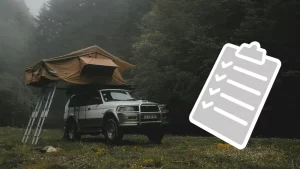When investing in a rooftop tent, it’s essential to think beyond the obvious and immediate features. Picture your long-term camping experiences and how each aspect of the tent contributes to your adventure. Also consider how the number of people, weather swings and general climatic conditions can effect you and your travel companion(s).
The interior space is possibly the most important component, and I want to address it early in this discussion for good reason. A rooftop tent is primarily for sleeping in, so comfort must be at the top of the list and I don’t mean how inviting the mattress is—at least not yet. We’ll look more closely at that later.
MATTRESS SPACE: FINDING THE RIGHT FIT
How many occupants do you anticipate? Are you planning for cozy nights with two adults, or is this a family tent that will accommodate children as well? If you’ve ever shared a bed with kids, you are already aware of how their restless sleep can impact your comfort!
Ensure the mattress length is adequate for the tallest member of your party, and be mindful of sloping walls. Manufacturers often boast about mattress dimensions, but if roof angles encroach on sleeping space, it’s definitely worth paying attention to their true usability.
Room to relax inside
European weather can be notoriously unpredictable. There may be days when you find yourself seeking refuge from a storm, with your doors and windows zipped tightly shut. Consider the dimensions of the tent when accommodating two, three, or even four individuals in a confined space. Is there enough room to move about without tempers fraying? Can everyone sit upright comfortably?
Seasonal Considerations: Dressing for the Weather
When do you plan to use your tent? In the warm summer months, slipping into a t-shirt and shorts is easy. However, when the chill sets in, bulkier clothing becomes necessary. Evaluate whether there’s ample space to dress and undress comfortably, as well as to stow bulky jackets and trousers overnight.
If the forecast holds promise of inclement weather, consider where you’ll place your shoes or boots. Some tents provide along the side and at the foot end of the mattress for footwear, but does yours offer external storage options for wet or muddy shoes? The same goes for shoes that have picked up dry sand—trust me, it takes ages to clean the mattress without a vacuum cleaner.
Entrance Wall: Weather Resistance Matters
One aspect often overlooked is the entrance wall, particularly in terms of how it affects your interior space in stormy, wet weather. This consideration applies to both sloping and vertical walls. Typically, the door unzips from bottom to top; once the tension is lost, it can flap in the wind, allowing rain to infiltrate your space. Entering or exiting your tent could lead to damp bedding, so having a large towel on hand can safeguard your mattress when rain is forecast. Simply drape it over your bedding while the door is open, and you’ll protect your comfort.
WHICH TENT STYLE OFFERS THE MOST SPACE?
When it comes to maximising interior space, soft-shell tents typically take the lead. These tents double in size when fully deployed, featuring vertical side walls that enhance overall headroom. Additionally, small porches often shield the entrance and windows from the elements. The integrated frame hoops, designed into the tent fabric, elevate the structure when opened, ensuring that available space is utilised effectively. Importantly, the walls at both the head and foot of the mattress have a minimal impact on the overall length of the mattress, allowing for increased sleeping comfort.
On the other hand, hard-shell tents tend to have outer dimensions that slightly exceed the mattress size. If you opt for a wedge-shaped model, bear in mind that a shallow angle on the lid may hinder usability on one end of the mattress. Also, most hard-shell tents have gas struts for easier opening, which are located inside the living space and may affect your movement.
Should your hard-shell tent feature a vertical opening with four upright walls, you’ll find that scissor supports are also placed inside on two sides. This design can encroach on available space, so it’s important to assess this when making your choice.
Always ensure that entrance and window openings are adequately protected from rain when in use.
Hybrid tents present an appealing blend of soft- and hard-shell designs. The width of the mattress dictates the size of the hard shell, while the length benefits from the fold-out feature, providing ample room. These hybrid models use smaller gas struts, making them less intrusive than those found in full-sized hard shells, thereby contributing to a more spacious interior feel.
Finally, look closely at the entrance wall, which is generally designed to be fairly upright. However, inspect the angle of the roof to ensure it won’t adversely affect the length of the mattress.







